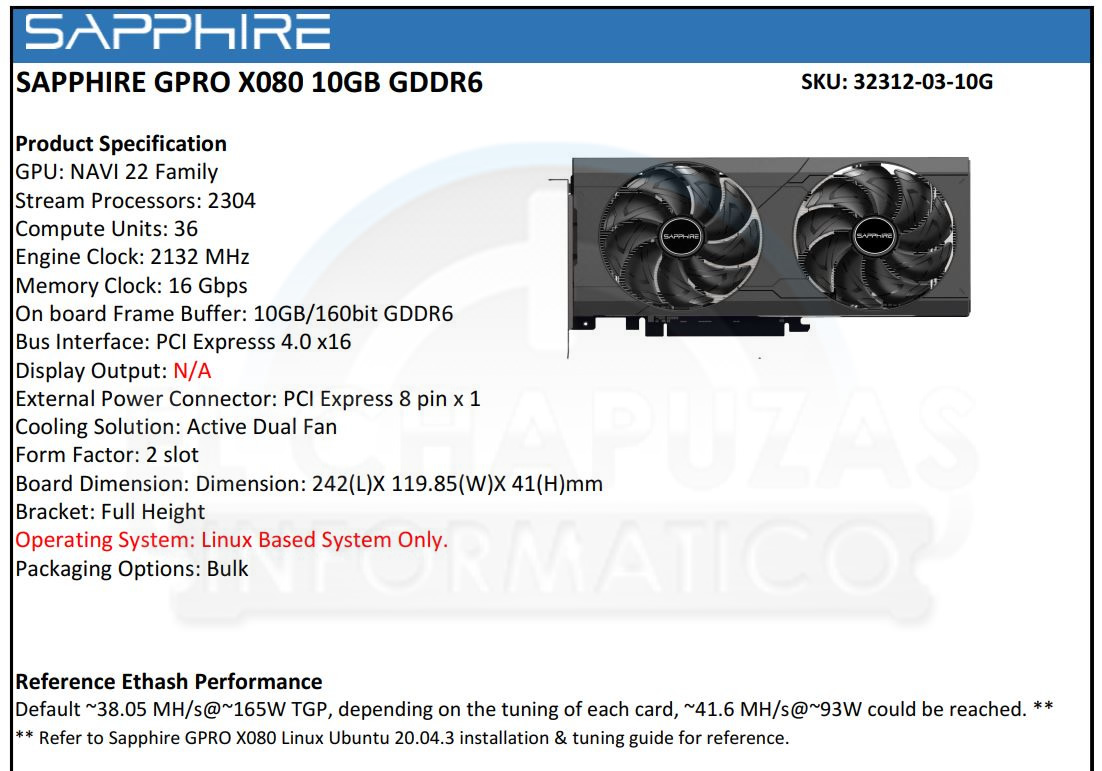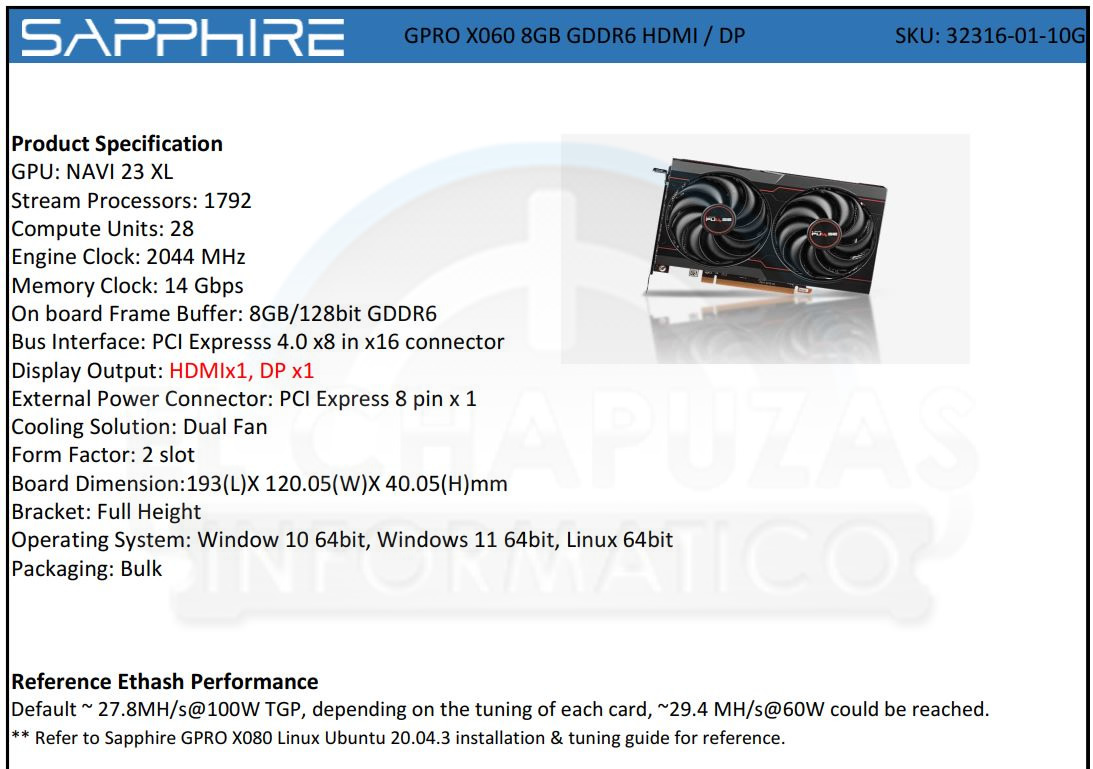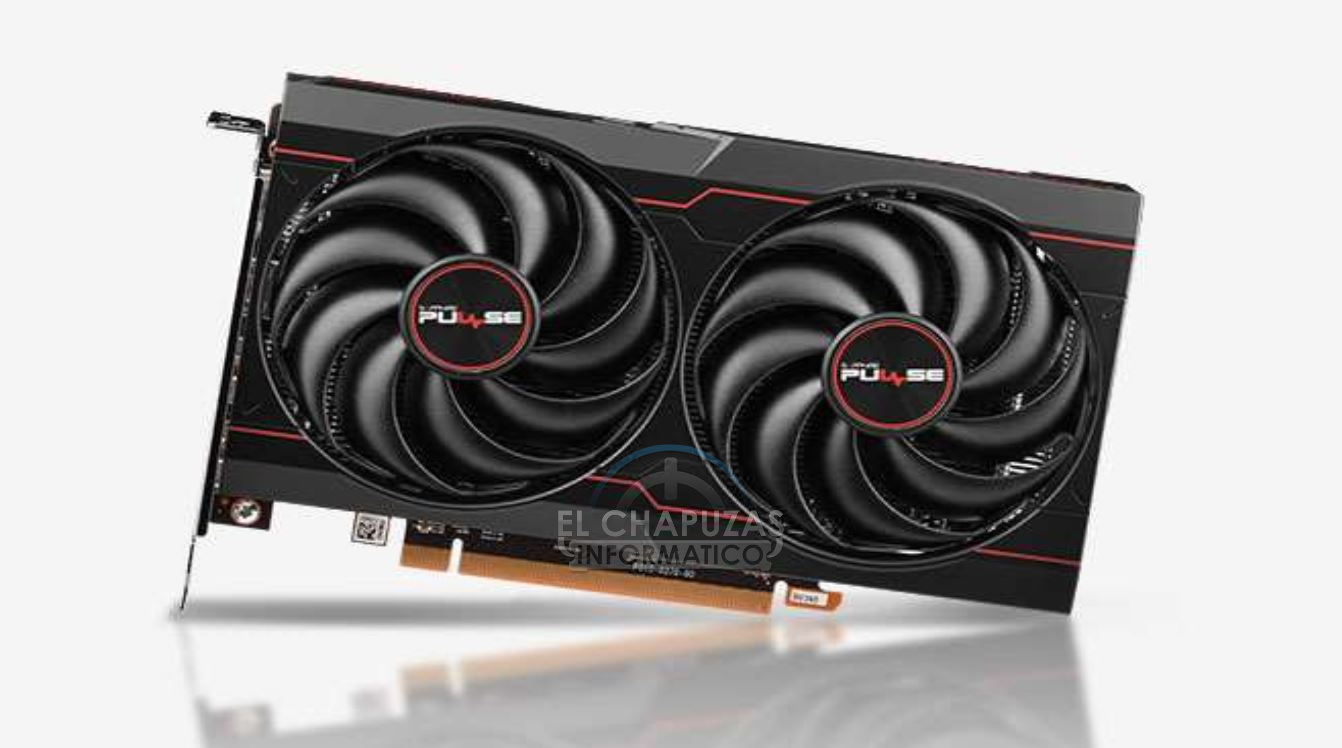Sapphire Radeon X080 and X060 RDNA2 Mining Cards Spotted
Secretly marketed for cryptocurrency mining?
Spanish-language website El Chapuzas Informático has leaked a pair of supposed RDNA2-based Sapphire mining cards. According to the site, AMD board partners are catering to the demand of cryptocurrency mining, in a market that's sorely lacking in supply.
According to the leak, the Sapphire GPRO Radeon X080 and X060 accelerators are based on Navi 22 and Navi 23. The accelerators are marketed by Sapphire according to their MH/s capabilities - but these cards are impossible to find in mainstream outlets, and are even absent from the manufacturers' website. Naturally, as all of this information is via a leak it should be taken with adequate amounts of salt.



El Chapuzas Informático has gained access to two product sheets for these Radeon X080 and X060 accelerators - with the higher numbering indicating higher mining performance. The Sapphire GPRO X080 is rated for 38.0MH/s @ 165W TGP, with Sapphire claiming a maximum 41.6MH/s @ 93W TGP after optimizations to power consumption. The Sapphire GPRO X060 shows slightly lesser performance: it's rated for 27.8MH/s @ 100W TGP, or 29.4MH/s @ 60W TGP after optimizations.
According to the leaked specifications, the Sapphire X080 is based on the Navi 22 silicon, sporting 2,304 Stream Processors (SP) clocked at 2,132MHz. The 10GB of GDDR6 memory clocked at 16Gbps sends information through a PCIe Gen 4.0 x16 interface across a 160-bit bus. As Linux is the premier platform for mining, the card is being reported as only supporting the Linux operating system. Being specifically geared for cryptocurrency mining, the X080 features a headless design - completely bare of any display connectors. El Chapuzas Informático estimates pricing for each X080 accelerator to be set at €750 (~$846).
The GPRO X060, on the other hand, is based on the Navi 23 XL chip with 1,792 SPs, offering a boost clock of 2,044MHz, and 8GB of 14 Gbps GDDR6 memory across a 128-bit interface (limited to 8x PCIe 4.0 despite it having a 16x physical connector). Interestingly, the X060 has DisplayPort and HDMI outputs, so the card can theoretically be used for workloads other than pure mining. The GPRO X060 is estimated to retail for around €550 (~$620).
Get Tom's Hardware's best news and in-depth reviews, straight to your inbox.

Francisco Pires is a freelance news writer for Tom's Hardware with a soft side for quantum computing.
-
ezst036 Yes! Finally AMD mining cards! Hopefully Intel introduces some of these next year as well. Miners and gamers really need market/product divergence away from each other.Reply -
-Fran- Reply
So you're fine with the fact GPUs that could have been used for proper Video Cards to be made mining cards instead, which zero re-sale value and become more electronic waste after the miners move onto the next better mining card? Really? Because you do realize the GPU inside a miner card could have been used for another regular video card, right?ezst036 said:Yes! Finally AMD mining cards! Hopefully Intel introduces some of these next year as well. Miners and gamers really need market/product divergence away from each other.
Regards. -
TJ Hooker The X060 "mining accelerator" seems to be identical to a regular RX 6600 except with a couple less display outputs.Reply
The X080 seems to be a little bit custom, in that it's a Navi 22 die but cut down further than existing products, in terms of both CU count and memory bus. -
ezst036 Reply-Fran- said:So you're fine with the fact GPUs that could have been used for proper Video Cards to be made mining cards instead, which zero re-sale value and become more electronic waste after the miners move onto the next better mining card? Really? Because you do realize the GPU inside a miner card could have been used for another regular video card, right?
Regards.
The e-waste argument is a red herring at a time when people are paying double or more for several generations old hardware. By the time these are indeed e-waste it will be because they're e-waste worthy, not because usable hardware was ditched early on.
So too is the "could have been used" issue. These are chips that are being recycled that were not production worthy.
https://www.tomshardware.com/news/nvidia-repurposes-turing-silicon-cmp-crypto-mining-gpus#xenforo-comments-3690003
When Nvidia launched CMP, the chipmaker was firm on the fact that it wouldn't impact the supply of its GeForce gaming graphics cards.
Using viable GPUs would impact the supply of Geforce gaming cards. To use a phrase, this is free silicon for the taking. Your contention may be correct on the AMD side as we know all of about nothing at the moment, but I suspect its the same situation. AMD will recycle defective dies that don't meet production specification. This is about as win-win as it can get. -
-Fran- Reply
Well, no to both points* you refute.ezst036 said:The e-waste argument is a red herring at a time when people are paying double or more for several generations old hardware. By the time these are indeed e-waste it will be because they're e-waste worthy, not because usable hardware was ditched early on.
So too is the "could have been used" issue. These are chips that are being recycled that were not production worthy.
https://www.tomshardware.com/news/nvidia-repurposes-turing-silicon-cmp-crypto-mining-gpus#xenforo-comments-3690003
Using viable GPUs would impact the supply of Geforce gaming cards. To use a phrase, this is free silicon for the taking. Your contention may be correct on the AMD side as we know all of about nothing at the moment, but I suspect its the same situation. AMD will recycle defective dies that don't meet production specification. This is about as win-win as it can get.
The waste argument is absolutely valid due to the volume in which the miners are buying these cards vs the normal people looking to game with them (even if they mine on the side). As soon as those GPUs don't turn a profit or it is more profitable to move to another card or tech to mine, those will get rid of. The cards with no re-sell value will go directly to the landfills and at least regular GPUs can go into the used market (as you say; old cards are still selling well). This segmentation is on behalf of nVidia's / AMD's bottom line and do not fool yourself by thinking this is due to them "thinking about those poor gamers with no access to GPUs". If they can control what miners get in bulk, then they also control, indirectly the used market. It doesn't matter how you want to spin it, the writing is on the wall for this one in regards to the short-lived and single-purpose life of those mining cards.
As for the chip manufacturing. I won't give neither AMD nor nVidia the benefit of the doubt in the way they phrase things. They have full overview on how they project their production lines on both consumer, proffessional, HPC and now mining. They allocate GPUs and do the trickling down vs what they want to sell in each segment. The between the lines reading there is: of course it won't interfere with the consumer cards if they just allocate less capacity to it and fullfill their internal quota. Yes, this is by no means easy to verify, but it's business. Why would you force your product to the lowest margin segment when you can make way more with even less effort? Again, don't fool yourself there.
Regards. -
TJ Hooker Reply
The dies used for Nvidia's CMP all have the same specs as their gaming GPUs so yes they could have been used for gaming cards (albeit older Turing/12nm for the most part), The only exception is the CMP 90HX, which uses a configuration of the GA102 dies that isn't (currently) used in a Geforce card. But it could be, i.e. they could release a 3070 Ti Super (or whatever they want to call it) that uses such a die config to make use of those dies in gaming cards if they wanted to. Or just cut it down slightly further to be used as a 3070 Ti.ezst036 said:The e-waste argument is a red herring at a time when people are paying double or more for several generations old hardware. By the time these are indeed e-waste it will be because they're e-waste worthy, not because usable hardware was ditched early on.
So too is the "could have been used" issue. These are chips that are being recycled that were not production worthy.
https://www.tomshardware.com/news/nvidia-repurposes-turing-silicon-cmp-crypto-mining-gpus#xenforo-comments-3690003
Using viable GPUs would impact the supply of Geforce gaming cards. To use a phrase, this is free silicon for the taking. Your contention may be correct on the AMD side as we know all of about nothing at the moment, but I suspect its the same situation. AMD will recycle defective dies that don't meet production specification. This is about as win-win as it can get.
Edit: Wasn't considering the 170HX or 220HX here, as I believe those are still only rumors. /Edit
The situation appears to be similar for these purported AMD mining cards. As I said above, based on the specs in this article the X060 dies are the exactly the same as the dies used for RX 6600 cards. The X080 dies could be used for the long-awaited RX 6700 non-XT.
As far as when the cards will stop being used, that'll happen when they're no longer profitable to mine. That could be many years away, or it could happen in a matter of months, no one can say for sure. -
ezst036 Reply-Fran- said:Well, no to both points* you refute.
In regard to manufacturing and use of recycled dies, I've been looking at other sites and noticed that Tom's has written about this recycling several times as well but all of these sites are careful to say they only suspect that the case. So you're correct it isn't confirmed. Here's another:
https://www.tomshardware.com/news/nvidias-cmp170hx-in-the-wild-with-164-mhps-ethereum-mining-performance
The CMP 170HX is likely made via defective, harvested chips that didn't make it into the company's A100
It would only work if recycling dies. If they are using perfectly viable dies as you suspect then mining cards is a ridiculous proposition. Hopefully Nvidia and/or AMD confirm this some day. It is a reasonable thing to suspect though - what does Nvidia do with a defective A100?
The problem is is that without re-basing as a miner card then these are already going to e-waste, it just happens on day 1. Surely you realize that? So using defective chips for market divergence just makes too much logical sense. Having them not go to e-waste for a 3-5 year period or even 1 year in a miner's rig is better than throwing them away at the fab. -
ezst036 ReplyTJ Hooker said:The dies used for Nvidia's CMP all have the same specs as their gaming GPUs so yes they could have been used for gaming cards.
I didn't know that. The speculative forecasts about "viability" on part of some of these authors caught me.
If they're not using recycled dies then is a ridiculous proposition to have miner cards.
But the reality is that unviable dies are e-waste on day 1. Making them into miner cards gives them months or years of viability first. In other words, in this scenario miner cards reduce e-waste, not increase it. Everybody wins. In the end we do need market divergence with Nvidia/AMD/Intel making miner-specific products that don't affect GPU supply and separate "us" from "them". The status quo clearly doesn't work. We can't keep fighting over the same silicon. -
TJ Hooker Reply
If a die is partially defective they can just use it in a lower tier model, the same as they've always done for all their GPUs. Are you aware that the A100 uses the GA100 die that has 8192 CUDA cores, but the A100 itself only has 6912 active? Meaning that the A100 is already using partially defective dies. If the dies have too many defects to be used for an A100, they could just release it as a A80 or whatever.ezst036 said:It would only work if recycling dies. If they are using perfectly viable dies as you suspect then mining cards is a ridiculous proposition. Hopefully Nvidia and/or AMD confirm this some day. It is a reasonable thing to suspect though - what does Nvidia do with a defective A100?
The problem is is that without re-basing as a miner card then these are already going to e-waste, it just happens on day 1. Surely you realize that? So using defective chips for market divergence just makes too much logical sense. Having them not go to e-waste for a 3-5 year period or even 1 year in a miner's rig is better than throwing them away at the fab.
Although the A100/GA100 aren't designed for gaming, so they arguably aren't relevant here.